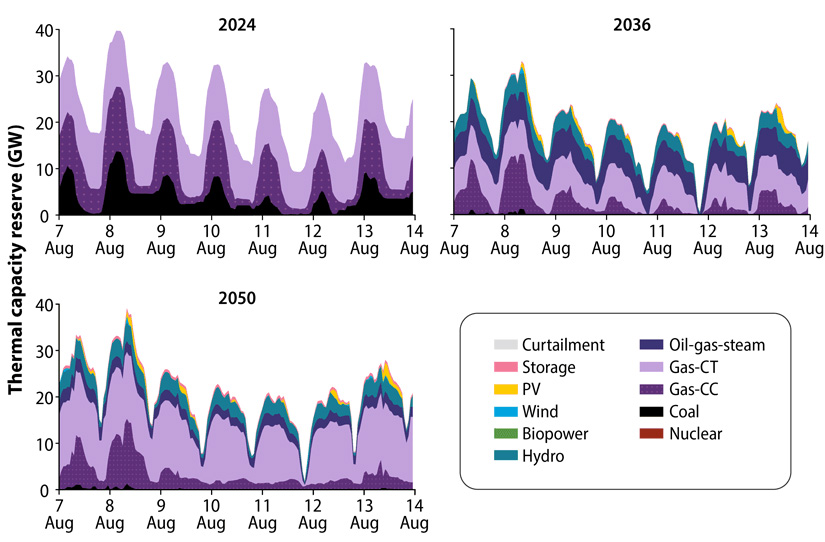Extreme Weather Events
An analysis conducted by NREL researchers and energy meteorology consultancy Sharply Focused will help system planners, policymakers, and researchers assess the operation of future power systems during extreme weather events.
Evolution of a cold wave in February 2011, showing countrywide temperature (right) and historical electrical load for select regions (left).
Evolution of the same 2011 cold wave, showing aggregate electrical generation for select regions (top left), wind resource (top right), historical load for the same select regions (bottom left), and solar PV resource (bottom right).
Extreme weather events—such as intense heat and cold, storms, and hurricanes—significantly impact our power grid today. However, different, less newsworthy weather events may be more concerning to the highly decarbonized future grid. In a grid with large shares of wind and solar generation, when hot or cold temperatures producing high, but not necessarily extreme, demand coincide with periods of low renewable resources across broad areas, the result will be high residual demand that must be met by storage, traditional power sources, or demand response.
As weather-dependent renewable generation grows, it is important to understand the relationships between renewable resources and load, especially as heating and cooling is increasingly electrified. In a power grid with large shares of renewable generation, periods of high system risk no longer correspond only to peak load hours and are associated with a broader and more nuanced range of weather conditions. Accordingly, reliability assessments in long-term planning studies done by utilities and grid operators may change dramatically in the coming years. This will impact how utilities and grid operators assess reliability in long-term planning.
Download the full extreme weather events study.
NREL and Sharply Focused conducted an analysis to address the following questions:
- Will increasing levels of wind and solar generation intensify the challenges of reliably operating the power system during extreme weather events?
- Will increasing levels of wind and solar generation change which events would be considered extreme weather?
The study used high-resolution datasets of historical load, weather, wind, and solar resources covering the years 2007–2013.
Key Findings
- Wind and solar generation tend to be available during the extreme weather events of today, though exceptions exist.
- Moderate weather conditions, more so than the extreme events in Finding 1, can produce extended periods of low wind and solar resource and need to become a focus of planners to ensure system adequacy.
- The greatest risk to adequate operation of the future grid during winter storms and cold waves shifts from the time of lowest temperature and peak load to the period following this of less extreme but still cold weather accompanied by low winds. These periods can last several days.
- Increased PV capacity drives system operational changes during heat waves, but adequacy concerns are driven by wind availability after sunset when load remains high.
- Flexible infrastructure can enable planning for geographic diversity.
- Hydropower availability and flexibility are key to mitigating system stress during extreme weather events.
- During extreme cold temperature events when wind turbines are shut down, local gas generation is required to meet demand. The incidence of cold temperature shutdown can be dramatically reduced through use of cold weather packages.
- Renewable resource availability is less impacted by extreme weather events than by direct damage to generation, transmission, and distribution infrastructure.
Eastern Interconnection

In the February 2011 and 2008 cold waves, wind and solar continue to serve 50% of the load after the front moves through while the load is elevated. Graphic by NREL
High Penetration of Renewable Energy
Today, weather typically stresses grid resilience by creating peak loads. Cold waves increase heating demand, and heat waves elevate cooling demands. At the same time, extreme cases of these events cause power plant derates, outages, and/or fuel supply constraints. In the future, weather events that lead to low wind or solar generation will produce periods where renewables meet less demand than they normally do resulting in periods of risk that may not coincide with typical summer and winter peak load days. In the worst-case scenario, these two forces could occur together. Fortunately, the authors of this study found that this doesn’t happen because the most extreme cold is associated with strong winds pushing cold air into a region, while extreme heat requires strong insolation and thus is coincident with average or better solar generation.
Grid Resilience During Renewable Energy Surplus or Deficit

This non-newsworthy weather event leads to depletion of thermal capacity reserves. Graphic by NREL
At high renewable energy penetrations, weather events that are important to the electric system will be not just those producing extreme loads and stressing traditional generators but also those that produce a large surplus or deficit in renewable energy resource availability. During periods of surplus renewable energy, grid operators face the challenge of efficiently storing valuable energy instead of just curtailing it. Meanwhile, adequacy must be assured during prolonged cloudy periods and/or low wind spells limit wind turbine performance. The authors found that low wind periods frequently occur in the days following a severe cold wave as a stable high-pressure system moves in. During such scenarios, conventional power sources and energy storage systems become pivotal in maintaining a stable power supply.
Meteorological intelligence in generation planning and accurate weather forecasting in operations are crucial for anticipating potential challenges to grid resource adequacy. Utilizing advanced predictive analytics, grid operators can make informed decisions about energy demand, potential renewable energy generation, and the need for supplementary power sources.
Publications
A Weather Analysis for Xcel Energy’s 2030 Colorado Preferred Plan, NREL Technical Report (2024)
Contact
Share

